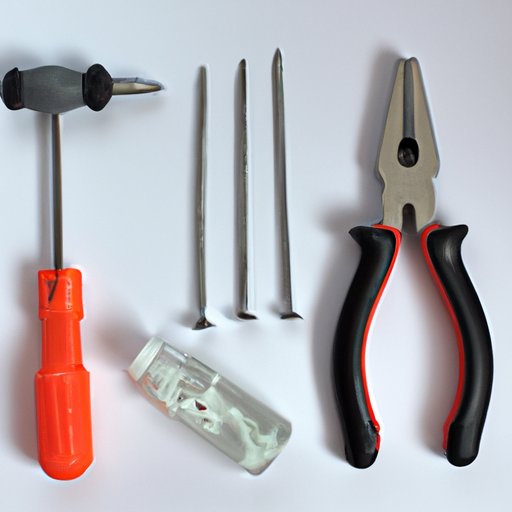Introduction
Stripped screws can be a frustrating and time-consuming problem to deal with. Whether you’re trying to remove a screw that’s been stripped by wear and tear, or you accidentally over-tightened a screw and stripped it yourself, it can feel like an impossible task. However, with the right approach, getting out a stripped screw is easier than you might think.
In this article, we’ll explore five methods you can try to remove a stripped screw, ranging from simple household items to specialized tools. Each method comes with step-by-step instructions and information about their benefits and drawbacks. By the end of this article, you’ll be equipped with the knowledge you need to tackle stripped screws like a pro.
Rubber Band Method
The rubber band method is a simple but effective technique that requires nothing more than a rubber band. Here’s how to do it:
- Place a rubber band over the stripped screw head, making sure it covers the entire head.
- Press down on the screwdriver while turning it, gripping the rubber band at the same time.
- The rubber band will help to grip the screw and increase friction, making it easier to turn.
- Keep turning the screwdriver until the stripped screw comes out.
The benefits of the rubber band method are that it’s quick, easy, and requires no additional tools. It also doesn’t damage the surface around the screw head, making it a good option for delicate materials. However, it may not work as well on screws that are deeply embedded or severely stripped.
Pliers Method
If the rubber band method doesn’t work, the pliers method is another simple approach you can try. Here are the steps:
- Choose a pair of pliers with a strong grip and a shape that can fit around the stripped screw head.
- Clamp the pliers tightly onto the head of the screw, making sure to align them accurately.
- Turn the pliers counterclockwise, using gentle pressure to grip the screw tighter.
- If the screw begins to budge, keep turning until it comes out completely.
- If the screw won’t budge, stop attempting to turn it. You don’t want to risk damaging the screw head or surrounding material.
It’s important to note that the pliers method can sometimes strip the screw head even further, especially if the pliers don’t align correctly. However, if done carefully, it can be an effective method for removing moderately stripped screws.
Hammer Method
The hammer method is a more forceful technique for removing stripped screws. Here’s how to do it:
- Choose a flathead screwdriver that is slightly larger than the stripped screw head.
- Place the tip of the screwdriver into the center of the stripped screw head.
- Use a hammer to tap the end of the screwdriver gently, turning it counterclockwise at the same time.
- The impact from the hammer should help to loosen the screw and make it easier to turn.
- If the screw begins to turn, keep going until it’s fully removed.
- If the screw still won’t turn, stop attempting to remove it. Continuing to use force could damage the screw or the material surrounding it.
It’s important to use the hammer method with caution, as too much force can cause damage to the surface surrounding the screw. It’s also not recommended for use on delicate materials.
Vinegar Method
The vinegar method is a chemical approach that can help to dissolve rust and corrosion on stripped screws. Here’s how to do it:
- Pour white vinegar into a small container.
- Place the stripped screw head into the vinegar and let it soak for at least 15 minutes.
- Use a pliers or screwdriver to attempt to turn the screw clockwise and counterclockwise.
- If the vinegar has done its job, the screw should come out easily.
The benefits of using vinegar are that it’s a simple, low-cost approach that doesn’t require any specialized tools. It’s also environmentally friendly compared to some chemical alternatives. However, it may not work as well on screws that are severely rusted or corroded.
Screw Extractor Method
If all else fails, the screw extractor method is a specialized approach that can help to remove extremely stubborn, stripped screws. Here’s how to do it:
- Choose a screw extractor with a size and shape that matches the stripped screw.
- Drill a small hole into the center of the stripped screw head, making sure to use a drill bit that’s slightly smaller than the extractor.
- Insert the extractor into the hole and turn it counterclockwise slowly.
- The extractor will grip onto the inside of the screw and help to turn it out.
- If the screw begins to turn, keep going until it’s fully removed.
The benefits of using a screw extractor are that it’s specifically designed for removing stripped screws and is often more effective than other methods. However, it does require a bit more effort and specialized tools than the other approaches discussed in this article.
Conclusion
Removing stripped screws is never fun, but with these five methods, you should be able to tackle the problem with ease. It’s important to start with the simplest techniques and progress to more specialized approaches if necessary. Try each method until you find one that works for the specific screw you’re trying to remove.
Remember to be patient and cautious when attempting to remove stripped screws. Rushing or using too much force can cause damage to the screw or the surrounding material. With a little bit of patience and the right approach, however, removing stripped screws can be a simple and stress-free process.
